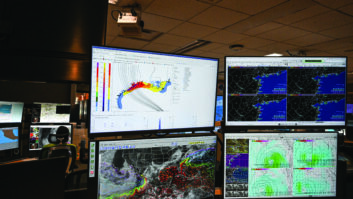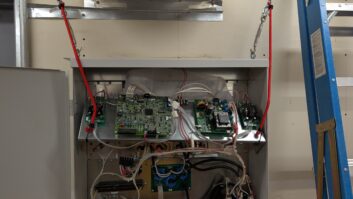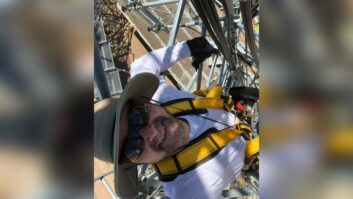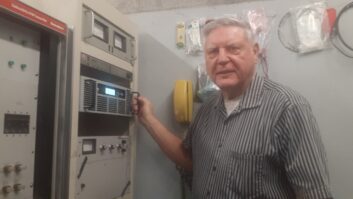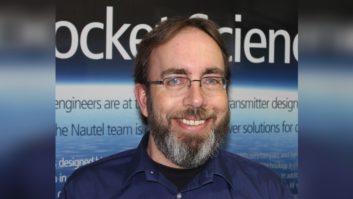• Wednesday morning April 18
“Surround for Radio”• Wednesday morning April 18
“Emerging Broadcast Technologies”• Wednesday afternoon April 18
“Engineering Management for the 21st Century”by Alan Carter and John M. Lyons
One in a series of day-by-day descriptions of events at the upcoming Broadcast Engineering Conference of NAB2007.
HD Radio is not just about sound quality.
Across the board, the engineering community is seeking answers to associated technology issues such as surround sound, interactive radio and data management.
Wednesday sessions at the NAB Broadcast Engineering Conference focus on these topics and others.
SURROUND FOR RADIO
Surround sound has grown beyond TV and the theater. Radio is exploring the possibility of offering listeners multi-channel audio as part of the HD package.
Broadcasters have the opportunity to hear the latest during “Surround Sound for Radio” on the morning of April 18.
“I want people to walk away knowing that surround sound is here today, and it works,” said Steve Fluker, chairman of the session and director of engineering for six Cox Radio stations in Orlando, Fla.
“Implementing Surround Sound in a Broadcast Facility” is the lead presentation, given by Fluker.
He will report on the implementation section of the new National Radio Systems Committee surround paper, “Broadcasting Surround Sound Audio Over IBOC Digital Radio — Issues and Resources for FM Broadcasters.”
“My presentation is a parallel complement to the paper,” Fluker said. “Most important, the NRSC paper is an educational piece on surround sound.”
He will review the different methods of surround and how stations can implement surround: from the basic music-only to a full-blown operation with a production studio that produces local elements and commercials in surround, including full discrete 5.1 production and master control.
“I think surround sound has become forefront in people’s minds with home theaters and with movie theaters,” he said. “Surround sound awareness is there.” He also added that surround sound is a bonus “to sell” HD Radio.
The NRSC paper is available for download online at www.nrscstandards.org. The paper is a detailed description of surround for radio, Fluker said, and outlines the scenarios and the equipment available.
“5.1 for Radio: Too Much Too Soon?” is by Jon McClintock, commercial director of APT, which is based in Belfast, Northern Ireland.
McClintock will outline case studies in which APT worked with broadcasters to implement surround. He will address technical issues involving audio contribution and distribution.
“Surround Sound Radio Broadcasting Is Reality,” the third in the series of topics, is from Don Danko, vice president of engineering at Cincinnati Public Radio in Cincinnati.
CPR station WGUC(FM) was the first station in the country to broadcast commercially available surround sound recordings. The broadcasts are from a series of surround recordings at such venues as the Cincinnati Symphony Orchestra, the Cincinnati Opera, the Linton Music Festival and the May Festival.
Danko will discuss the station’s evaluation and implement of surround including encoding, on-air testing, implementation and ongoing broadcasts.
He said WGUC started conducting surround recordings in the late 1990s. With the recordings, he said the station had its own source audio, and it made perfect sense to put them on-air.
The reaction has been positive from listeners. But, he continued, the station had to educate listeners on which receivers to buy to match the station’s encoding. “You have to find a happy medium of promotion,” Danko said.
While Danko said there is “some cross-compatibility” among the surround encoding processes, for the full effect the receiver needs to match the decoding.
“Radio Surround Gets Ready for Prime Time: New Techniques for Surround Mixing” is next on the lineup from Alex Kosiorek, director of audio services at the Cleveland Institute of Music.
Kosiorek said he will present a primer on the entire surround process and delve into mixing for a live broadcast. He has recorded and produced events and groups including the Cincinnati Symphony Orchestra.
He will cover all aspects including miking, mixing, transport protocols and broadcast facility requirements. He also will talk about new surround applications that can make these broadcasts more efficient, and he will cover surround mixers that allow for more creativity.
“I will speak on the entire gamut from front to back,” Kosiorek said.
Among the factors high on his list that would make for a successful surround broadcast is format: rock, jazz, classical and “some” pop.
“With surround sound, the radio experience can be more fulfilling,” he said. “The range of the listening experience increases.”
“Internet Radio in Surround Sound” is the last program in the morning session.
Nikolaus Faerber, group manager for multimedia transport at the Fraunhofer Institute for Integrated Circuits IIS in Erlangen, Germany, will report on developments and testing in surround for Internet broadcasting.
EMERGING BROADCAST TECHNOLOGIES
From digital broadcasting for medium-wave radio to issues about data management for multi-platform radio, the “Emerging Broadcast Technologies” session, also on Wednesday morning, offers a broad overview.
“This program was designed to help people become aware of technologies that may not yet be mainstream but are emerging,” said Graham Jones, chairperson of the session and director of communications engineering for NAB. Three presentations are of particular interest to radio attendees:
“DRM Progress Toward Standardization in the Broadcast Frequencies Between 30 and 108 MHz” leads off the session.
Donald Messer, technical committee chairman for Digital Radio Mondiale, said he will outline the progress made on the technical side during the past year for the digital broadcasting system. DRM is an open standard digital on-air system for shortwave, medium-wave/AM and long-wave.
In particular, Messer said he will discuss developments in medium-wave and outline applications for local use, which he said has been successful in Europe and Mexico.
“Interactive Radio Has Arrived” shifts the focus of the program for radio to data management and the wide-reaching applications.
In this presentation, T.A. McCann, CEO of Jump2Go, which is based in Bellevue, Wash., will demonstrate how the new RDS Radio Text Plus will offer added value.
The RT+ standard enhances the RDS text service by allowing broadcasters to tap specific text under a variety of categories such as title and artist, much like an MP3 player. Thinking forward, it can permit radio “users” to store telephone numbers directly to cell phones if they are listing to radio on a cell phone with a receiver, and access Web addresses directly if they are listening over the Internet.
“Improved Data-Follow-Audio in Multi-platform Radio” examines text and other data accompanying radio audio and its application in analog radio, HD Radio, Internet broadcasting and even for mobile phones and billboards.
The program is presented by Allen Hartle, director of development for Broadcast Data Services at Broadcast Electronics, and Neil Glassman, vice president of strategic marketing at BE.
Glassman said this whole area is a natural extension for radio.
While the program will be on the technical side, BE will present a similar but less technical and more application-oriented version at the NAB Radio & Audio Stage in the North Hall. That presentation’s title sums up a main issue at stake: “Where HD Radio Meets Creativity, Revenue and Technology.”
Said Glassman, “We’re seeing new revenue potential.”
ENGINEERING MANAGEMENT FOR THE 21ST CENTURY
The Wednesday afternoon Broadcast Engineering Conference session will be chaired by Steve Davis, senior vice president of engineering for Clear Channel Radio.
As a 30-year broadcasting veteran, Davis has been on intimate terms with engineering management changes in the later part of the previous century and the early years of the new one.
“The face of the broadcast media facility is changing, and we as the technology leaders must continually look beyond what is common today, to what will be most efficient, productive and effective in the new digital, networked era,” he said.
Opening the session will be Benjamin Coe, managing principal of EYP Mission-Critical Facilities, on the subject of “Media Facilities in Transition: Change Management Planning and the Mission-Critical Media Facility.”
Attendees will see planning exercises in engineering and risk management, digital workflow and content delivery, and digital asset management and its effects on facilities planning. Coe will present big-picture facility issues such as upgrading in place or moving out of an existing facility, and will discuss strategies for migrating to a new workplace environment. Also presenting is Stephen Newbold of Gensler.
The session continues with “Good Asset Management Equals Smart Scheduling” by Andrew Janitschek, director of production support for Radio Free Asia.
“Convergence brings technology and society closer together,” he said. “Chief engineers and station managers must focus continually on their critical resources, especially people. Which is better for the human resource, stable or rotating schedules? Are firm or staggered shift times best? What are the fiscal effects? How does today’s manager balance the needs of the employees with those of the company?”
He will examine benefits and the pitfalls of common staff schedules and those that promote or hinder professional growth. Janitschek hopes to arm attendees with a greater understanding of their employers’ needs and a readiness to meet the other challenges of media asset management.
The afternoon agenda concludes with “Capital Budget Plan: A Tool for the Chief Engineer” by Mike Seaver, president of Seaver Management and Consulting Services.
“Nobody’s more qualified than an engineer to put together a budget,” he said. “Chief engineers need to become businessmen. They need to become multi-lingual. They need to speak engineers talk and money talk.”
The engineer, Seaver believes, must learn to present his or her cap-ex plan in a concise manner so upper management can understand it. Material must be prioritized clearly.
This session gives an engineer tools to make the capital budget process less painful and intimidating.
Alan Carter is the former editor-in-chief of Radio World International. John Lyons is assistant vice president and director of broadcast communications for The Durst Organization.
Wednesday BEC Sessions: Surrounded by Emerging Tech
One in a series of day-by-day descriptions of events at the upcoming Broadcast Engineering Conference of NAB2007.
